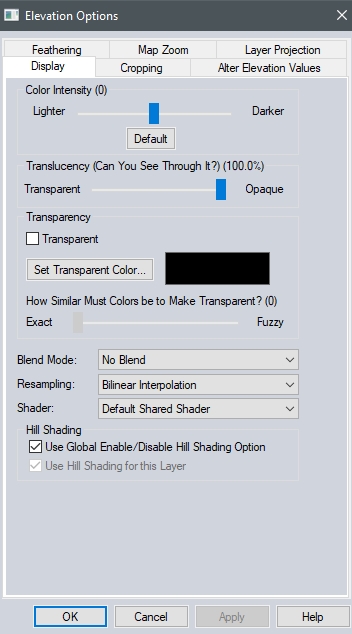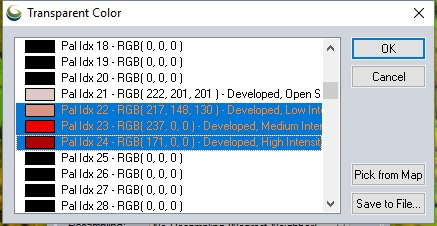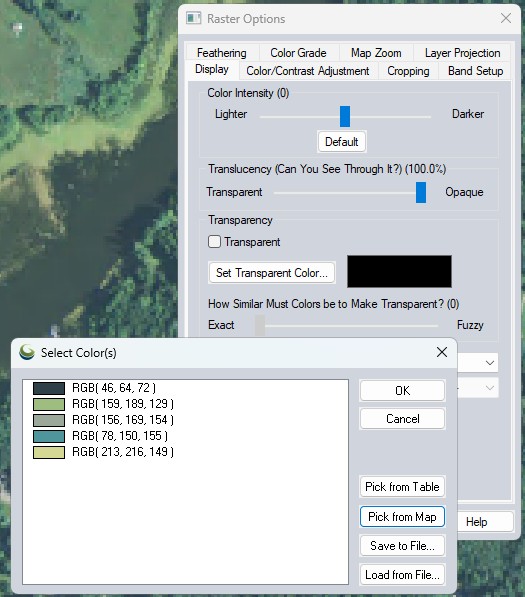Display Tab
The Display tab for Elevation Data (pictured below) contains controls allowing the user to control the color intensity (brightness/ darkness), color transparency, blending, anti-aliasing, and color shading of the selected layers.

Color Intensity
The Color Intensity setting controls whether displayed pixels are lightened or darkened before being displayed. It may be useful to lighten or darken raster overlays in order to see overlaying vector data clearly.
Translucency
The Translucency setting controls to what degree overlays underneath the selected overlay are visible. The default setting of Opaque means that underlying overlays will not be visible. Settings closer to Transparent make the overlay increasingly more see-through, allowing overlapping data to blend.
Transparency
In the Transparency section, the Transparent option allows a particular color (or colors) to be displayed transparently, making it possible to see through a layer to the layers underneath.
The Set Transparent Color... button allows the user to select the color to treat as transparent.
With palette files, the available colors will be automatically populated in the list on the left. Select multiple transparent colors using the CTRL or SHIFT key and clicking the palette colors. CTRL can also be used with the Pick from Map tool to pick multiple colors in a palette file.

With other raster files, the Transparent color list will be empty to begin with. Use the Pick from Map or Pick From Table buttons to add colors to the list. Highlighted colors will be set at transparent. Use the SHIFT or CTRL keys to highlight multiple transparent colors once picked.
Pick from Table - This option is available for imagery or elevation layers that do not contain a palette. This will display the Color selection dialog. Select a basic color, or use the settings on the right to fine tune the color by Hue, Saturation and Luminosity, or Red Green and Blue values.

Add to Custom Colors – This adds the color to the list of custom colors, shown below the basic colors.
Pick Color From Map – when this option is selected the cursor will change to an eyedropper. Click on any 2D map to select the color value at the cursor location.

Save to File – This will save the list of colors to a palette file.
Load from File - Use this option to load color from an external file such as a pallet (.pal) file.
The Exact to Fuzzy slider in the Transparency section controls how similar to the selected transparent color(s) that a color in the image has to be before it is also treated as transparent. The Exact side means that only exact matches on color will be treated as transparent, moving the slider towards the Fuzzy side makes progressively less similar colors be treated as transparent. This is useful for getting rid of colors in lossy formats like JPG and ECW where the colors are not exact.
To remove listed transparent colors, click Set Transparent Color and select a color from the list, then click the Delete key. To delete multiple colors at once, hold the ALT key and select multiple listed colors, then click the Delete key. To delete all colors, hold the SHIFT key and select the top most listed color and then select the bottom listed color, then click the Delete key.
Blend Mode
The Blend Mode setting controls how an overlay is blended with underlying overlays, in addition to the Translucency setting.
The Blend
Mode settings allow Photoshop-style filters to be applied to overlays,
resulting in often stunning results. The results from a particular set
of overlays from a particular blend mode setting can often be hard to
predict, so rather than try to understand what is technically happening
for each blend mode it's best to just experiment with different ones until
you find one that you like. The Hard Light setting seems to work well
with satellite imagery overlaid on DEMs, but the others can be quite useful
as well.
The Transparent option allows a particular color to be displayed transparently, making it possible to see through a layer to the layers underneath. For Example, when viewing a DRG on top of a DOQ, making the white in the DRG transparent makes it possible to see much of the DOQ underneath. Pressing the Set Transparent Color... button allows the user to select the color to treat as transparent in the selected overlay.
The Resampling
option allows the user to control how the elevation value for each displayed/export
location is determined based on the values in the file.
The following resampling methods are supported:
- Nearest Neighbor - simply uses the value of the sample/pixel that a sample location is in. When resampling an image this can result in a stair-step effect, but will maintain exactly the original color values of the source image.
- Bilinear Interpolation - determines the value of a new pixel based on a weighted average of the 4 pixels in the nearest 2 x 2 neighborhood of the pixel in the original image. The averaging has an anti-aliasing effect and therefore produces relatively smooth edges with less stair-step effect.
- Bicubic Interpolation - a more sophisticated method that produces smoother edges than bilinear interpolation. Here, a new pixel is a bicubic function using 16 pixels in the nearest 4 x 4 neighborhood of the pixel in the original image. This is the method most commonly used by image editing software, printer drivers, and many digital cameras for resampling images.
- Box Average (2x2, 3x3, 4x4, 5x5, 6x6, 7x7, 8x8, and 9x9) - the box average methods simply find the average values of the nearest 4 (for 2x2), 9 (for 3x3), 16 (for 4x4), 25 (for 5x5), 49 (for 7x7), 64 (for 8x8), or 81 (for 9x9) ) pixels and use that as the value of the sample location. These methods are very good for resampling data at lower resolutions. The lower the resolution of your export is as compared to the original, the larger "box" size you should use.
- Filter/Noise/Median (2x2, 3x3, 4x4, 5x5, 6x6, 7x7, 8x8, and 9x9) - the Filter/Noise/Median methods simply find the median values of the nearest 4 (for 2x2), 9 (for 3x3), 16 (for 4x4), 25 (for 5x5), 49 (for 7x7), 64 (for 8x8), or 81 (for 9x9) pixels and use that as the value of the sample location. This resampling function is useful for noisy rasters, so outlier pixels do not contribute to the kernel value. Some common sources of raster noise are previous compression artifacts or irregularities of a scanned map/image.
- Box Maximum (2x2, 3x3, 4x4, 5x5, 6x6, 7x7, 8x8, and 9x9) - the box maximum methods simply find the maximum value of the nearest 4 (for 2x2), 9 (for 3x3), 16 (for 4x4), 25 (for 5x5), 49 (for 7x7), 64 (for 8x8), or 81 (for 9x9) pixels and use that as the value of the sample location. These methods are very good for resampling elevation data at lower resolutions so that the new terrain surface has the maximum elevation value rather than the average (good for terrain avoidance). The lower the resolution of the export file is as compared to the original, the larger "box" size that should be used.
- Box Minimum (2x2, 3x3, 4x4, 5x5, 6x6, 7x7, 8x8, and 9x9) - the box minimum methods simply find the minimum value of the nearest 4 (for 2x2), 9 (for 3x3), 16 (for 4x4), 25 (for 5x5), 49 (for 7x7), 64 (for 8x8), or 81 (for 9x9) pixels and use that as the value of the sample location. These methods are very good for resampling elevation data at lower resolutions so that the new terrain surface has the minimum elevation value rather than the average. The lower the resolution of the export file is as compared to the original, the larger "box" size that should be used.
- Gaussian Blur (3x3, 5x5, 7x7) - the Gaussian blur methods calculate the value to be displayed for each pixel based on the nearest 9 (for 3x3), 25 (for 5x5), or 49 (for 7x7) pixels. The calculated value uses the Gaussian formula that weights the values based on the distance to the reference pixel.
Shader
The Shader
option allows the user to choose which elevation shader is to be used
for coloring the cell values within this layer. By default, all gridded
layers will share the elevation shader selected on the toolbar, but there
may be certain situations where you want to color one layer differently
than the others and exclude it from the loaded elevation range. One common
example is a gridded layer that actually has non-elevation data.
Check the Use
Global Enable/Disable Hill Shading Option to indicate that
the use of hill shading on this layer should be controlled by the global
option to enable or disable hill shading for all layers. The global option
can be changed from the Shader
Toolbar or from the Vertical Options
tab on the Configuration
dialog.
When the Use
Global Enable/Disable Hill Shading Option box is not checked, then
use the Use Hill Shading for this Layer
check box to control whether or not to use hill shading when the selected
layer is displayed. If this box is checked, the layer will have
hill shading applied regardless of the current value of the global hill
shading option.
If more than one elevation layer are selected, and those layers have different settings for Use Global Enable/Disable Hill Shading Option, then a light grey check will appear in the box. Any subsequent changes to the hill shading options will then be applied to all selected layers.